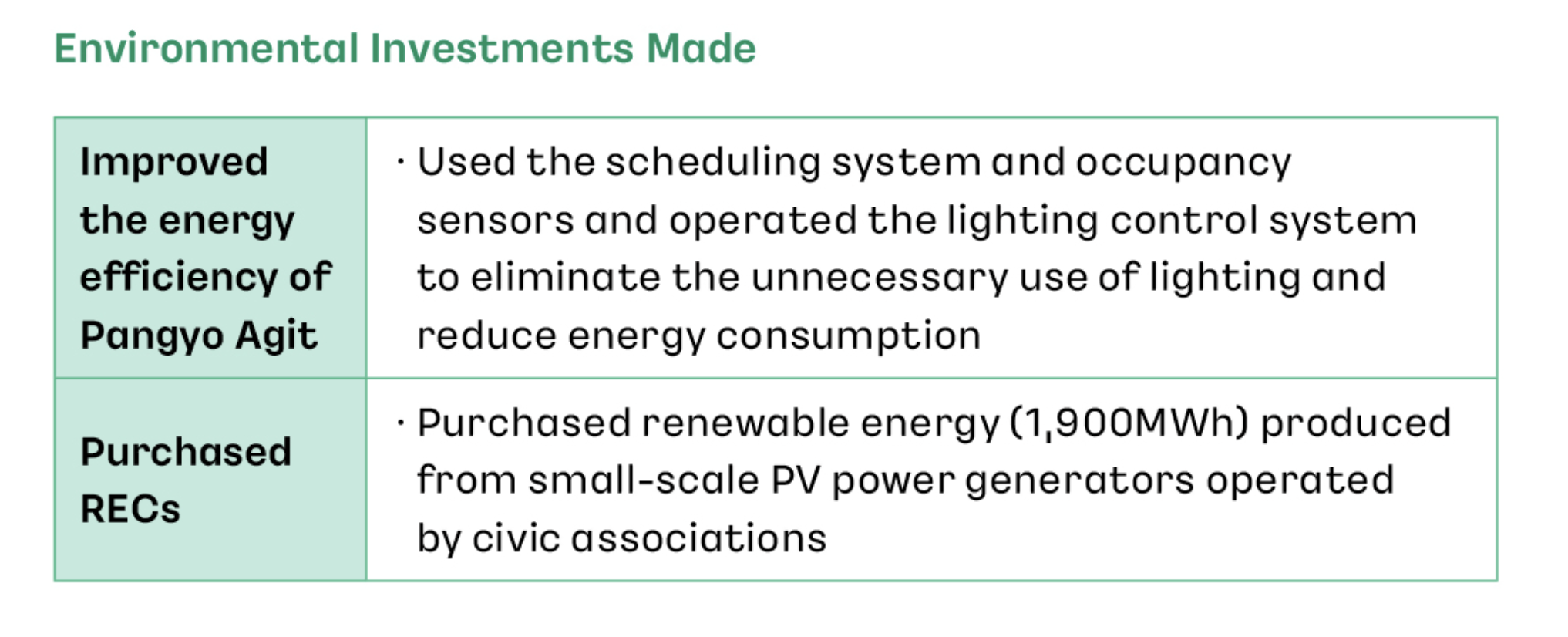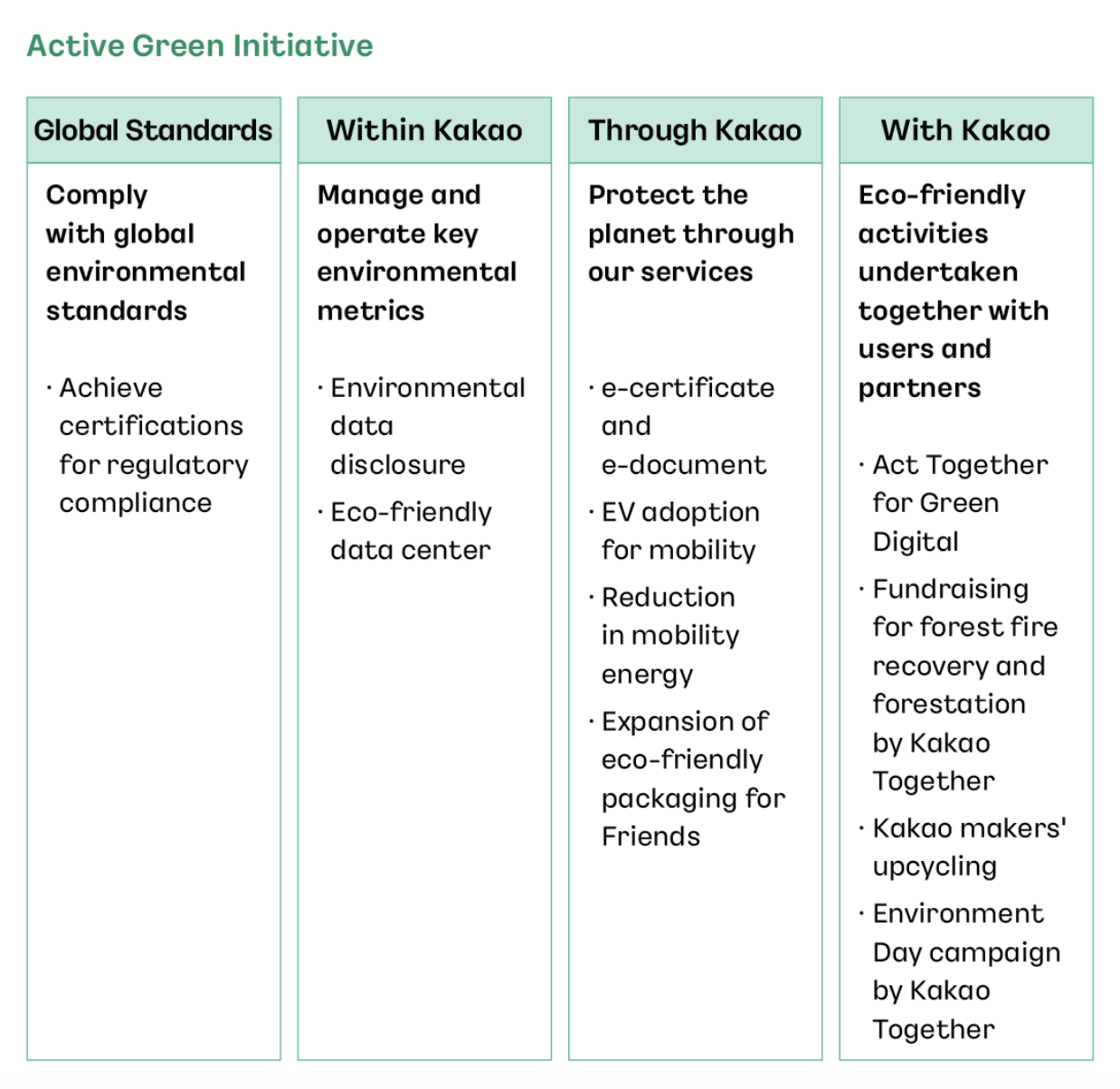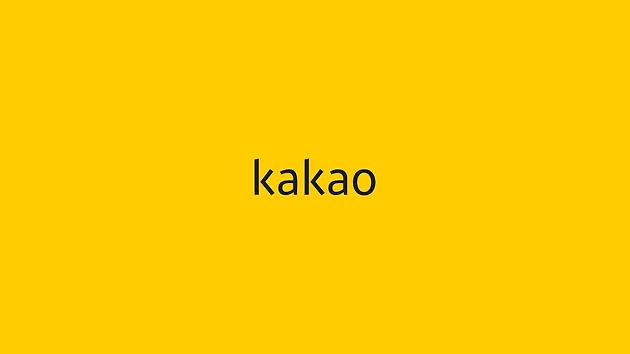Kakao’s Environmental Management Commitment
Ⅰ. Environmental Management System
We set forth our environmental policy to minimize environmental impact of our business operations and established governance to implement environmental management. Key environmental issues are regularly discussed at the Board of Directors and the ESG Committee. We systematically execute the environmental goals that we set and make eco-conscious investments to help resolve environmental issues.
Environmental Management Implementation System
▶ Environmental Policy
Kakao stipulated our environmental policy in 2021 to guide our implementation of environmental management. This policy drives us to minimize environmental impact from our service delivery and fulfill our responsibility for environmental pollution prevention and environmental protection. In 2022, this policy was updated with the addition of provisions concerning enterprise-wide environmental management governance. The Board of Directors, as the company’s highest decision-making body, makes decisions and oversees environmental performance and risks.
The operational organization, “ESG Management", is responsible for implementing the environmental policy, including establishing and executing environmental management strategies, operating the environmental management system, managing environmental performance, and responding to global initiatives.
The environmental policy applies not only to Kakao’s headquarters but also to its domestic and overseas affiliates and their members. Furthermore, Kakao requires its direct and indirect business partners to understand and comply with the policy, and encourages service users to practice it as well.
🔗 Kakao’s Environmental Policy
▶ Dedicated Environmental Management Organization
Kakao’s ESG Committee, under the Board of Directors, is responsible for overseeing environmental management and making key decisions. The ESG Committee convenes four times a year to review Kakao’s environmental strategies and activities. The executive of the ESG General Organization is delegated by the ESG Committee to manage the environmental impact of Kakao’s business activities and oversees the company-wide ESG strategy. Significant environmental management issues identified in this process are reported to the ESG Committee and Board of Directors to support related decision-making.
The ESG Management Team is responsible for establishing and executing environmental management strategies, operating the environmental management system, managing environmental performance, and responding to global initiatives. In addition, environmental management issues are shared weekly with the executive in charge of the ESG General Organization, and necessary discussions are held. Kakao also operates an interdepartmental working group called the Environmental Management Table, which facilitates the implementation of environmental management and the execution of improvement tasks by working departments.
▶ Environmental Management System
Kakao systematically identifies, assesses, and manages environmental risks based on the ISO 14001 environmental management system. We conduct annual inspections and improvement activities to maintain our certification and expand its application across business sites. The ESG Management Team sets company-wide environmental management goals and regularly consults with implementation departments through the Environmental Management Table to review the implementation status and discuss improvement measures for each business site. We conduct an internal audit annually to assess the adequacy of the environmental management system.
Our Jeju Office, Pangyo Office, and Kakao Data Center Ansan conduct regular environmental impact assessments to identify risks and implement improvement measures as needed. In 2024, Kakao Data Center Ansan acquired ISO 14001 certification, joining the Jeju Office and Pangyo Office, which obtained certification in 2021. As a result, all three business sites maintain ISO 14001 certification. This represents approximately 100% of all major business sites1). In March 2025, we conducted a post-certification audit to verify and improve the effectiveness of the environmental management system.
▶ Environmental Investment
Our Pangyo Agit, which accommodated Group members in 2022, achieved LEED (Leadership in Energy and Design) Gold under this green building certification system in March 2023. We signed an MOU with 60hz, an energy IT social venture company, to purchase renewable energy directly produced by community cooperatives. In so doing, Our Jeju Office met all its power needs with photovoltaic energy for the year of 2022. Furthermore, Kakao obtained LEED certification for its Ansan Data Center, which commenced operations in 2024, and was awarded LEED Gold certification in 2025 for the Yongin AI Campus.
 이미지 새창 열림
이미지 새창 열림▶ Environmental Goal
Kakao establishes and systematically manages annual environmental goals to reduce the environmental impact arising from its overall business operations. Each year, we aim to maintain Scope 1 and 2 greenhouse gas (GHG) emissions, water withdrawal, and waste generation at the same level as the previous year. In 2024, we additionally set a target of procuring 10,000 MWh of renewable energy to advance our RE100 commitment. In 2024, changes in our work system and the expansion of business sites led to increased energy demand and resource usage.
As a result, Scope 1 and 2 GHG emissions, water withdrawal, and waste generation all increased compared to the previous year. Although we faced limitations in achieving our original environmental goals, we exceeded our renewable energy procurement target through continued efforts to expand renewable energy use. Notably, we began generating renewable energy independently by installing solar power facilities at Kakao Data Center Ansan.
We also diversified external procurement methods for renewable energy, thereby strengthening the foundation for energy transition. Kakao plans to respond by building a more sophisticated environmental data management system that reflects the new operational environment and by introducing high-efficiency equipment and reinforcing eco-conscious operational standards.
Ⅱ. Climate Change Adaptation
We deeply concur on the severity of climate change and established our mid/long-term climate change adaptation goal to join in the global efforts to address climate change. With an overarching goal of achieving Net Zero emissions by 2040, we are working on multiple fronts to transition to EVs, increase the use of renewable energy, and manage supply chain carbon emissions to mitigate carbon emissions along the entire value chain as well as from our own operations.
2040 Net Zero Roadmap
▶ Net Zero Goal
We committed to our Net Zero goal to reduce our consolidated GHG emissions to zero by 2040, and joined the SBTi(Science Based Targets initiative) as the first Korean internet business to do so. We defined our SBTi-based goal to reduce our Scope 1&2 emissions by 40% in 2030 and by 100% in 2040 from the 2021 base year. As to Scope 3 emissions, we set a mid-term goal of achieving a 17% reduction by 2030 from 2021. We also joined the RE100, a global renewable energy initiative, in the first half of 2023 to fully switch to eco-friendly energy for 60% of our consolidated power consumption by 2030 and for 100% by 2040 to gradually lower our carbon emissions from power consumption.
[Scope 1] Transition to EVs
Scope 1 emissions directly generated from our business operations mostly stem from the use of vehicle fuel. We aim to reduce such emissions by switching to EVs for our commuter buses and corporate fleet vehicles.
[Scope 2] Increase the use of renewable energy
Starting with the full conversion of its Jeju Office to renewable energy, the company has been expanding its adoption of renewables. A portion of the electricity is sourced through citizen-participated energy cooperatives, contributing to mutual growth with local communities. In 2025, Kakao is realizing a self-generated energy transition by producing and using electricity directly through solar panels installed on the exterior of the Kakao Data Center in Ansan.
[Scope 3] Manage supply chain carbon emissions
To identify GHG emissions indirectly generated along the value chain, we calculated our Scope 3 emissions across all 15 categories in 2022, and disclosed our emissions in 13 relevant categories. The data will base our efforts to establish and advance our Scope 3 emissions management system.
 이미지 새창 열림
이미지 새창 열림Ⅲ. Active Green Initiative
Our the Active Green Initiative applies the Kakao’s Style to advancing environmental initiatives. This will help us abide by environmental regulations as part of our corporate social responsibility. We will transparently communicate to our stakeholders how we adapt to climate change and reduce our environmental footprint. Leveraging the strengths of our platforms, we will ensure our users join us on our journey to transition to a low-carbon society using our services.
Active Green Initiative
We stipulated our company-wide principles to resolve environmental challenges and respond to the climate crisis, and announced our Active Green Initiative which embodies our commitment to fulfilling our role in this regard. The Active Green Initiative focuses on the Kakao’s Style of contributing to the environment. This moves beyond merely reducing our carbon emissions to contributing to social sustainability with the wide spectrum of service offerings that we provide to the general public. Specifically, the Initiative aims to advance climate change adaptation with the Net Zero goal of reducing our GHG emissions to zero by 2040. Driven by the principles of ‘Within Kakao’, ‘Through Kakao’ and ‘With Kakao’, we ensure that our Krew, partners, users, and members of society all do their part in tackling environmental challenges
As part of our Active Green Initiative, we aggregate the eco-friendly impacts Kakao services and platform users made and disclose it as a numerical value we call the Kakao Carbon Index. Through the Kakao Carbon Index, we support our users' positive response to climate change and their participation in eco-friendly activities, and will strive to help make the transition to a low-carbon society.
🌳 Kakao Active Green & Kakao Carbon Index Beta
https://www.kakaocorp.com/page/responsible/activegreen?lang=KOR&tab=all
 이미지 새창 열림
이미지 새창 열림IV. Environmental Impact Mitigation Efforts
▶ Energy Management Programs
Kakao has built an assessment system at its in-house Ansan Data Center to manage energy consumption. The system identifies energy-intensive areas and uncovers opportunities to improve energy performance. In recognition of its energy efficiency efforts, Kakao received the “Energy Efficiency Award” at the “Energy Winner of the Year” ceremony organized by the Ministry of Trade, Industry and Energy, the Ministry of Environment, and the Korea Energy Agency in July 2025.
Kakao is also developing an energy-saving campaign for employees. The campaign is led by the General Affairs Department and aims to encourage employees to voluntarily practice energy conservation within office buildings and workspaces. Practical reduction initiatives — such as automatic lighting control and maintaining optimal indoor temperature for heating and cooling — are being reviewed and advised by the company’s Internal Environmental Management Committee, with plans to establish long-term internal guidelines based on these efforts.
Moreover, to better manage the energy usage in data center operations, Kakao provides data center employees with external training on energy efficiency, introducing best practices from other companies and the latest technological trends to strengthen their capabilities in energy saving and efficient operations.
▶ Waste Management Programs
In accordance with the Waste Control Act, Kakao annually monitors and reports the amount of business-site waste generation and disposal to government authorities. Using an environmental performance table, the company compares its target amount and actual waste generation as part of its ongoing efforts to reduce waste.
In June 2024, to celebrate Environment Day, Kakao organized a tumbler donation campaign at its in-house café and invested in cafeteria facilities to cut food waste. In June 2025, the company launched the “Green Oasis Challenge” at its Pangyo and Jeju offices to encourage employees to reduce waste by finishing drinks and snacks, using personal cups or tumblers, and washing and properly disposing of take-out containers, thereby raising awareness about waste reduction.
▶ Water Efficiency Management Programs
Kakao manages water usage at its in-house Ansan Data Center by adopting the Water Usage Effectiveness(WUE) index to evaluate water use efficiency. Specifically, we review and analyze water usage to identify opportunities for improving efficiency. As part of these efforts, it has applied a high-efficiency pre-cooling system that operates in three modes according to seasonal changes. It also reuses rainwater and emergency reserve water, achieving about 98% savings in water and sewage costs.
Kakao does not operate manufacturing processes and therefore does not generate industrial wastewater. Domestic wastewater and auxiliary water generated from office spaces and data center operations are managed in compliance with relevant regulations. Specifically, the company conducts regular septic tank cleaning and maintenance, periodic water quality inspections of water storage and greywater tanks, discharge water management and outsourced treatment, as well as regular inspections and third-party verification to ensure that the quality of discharged water is maintained at appropriate levels.
Additionally, through the “Green Oasis Challenge” held at its Pangyo and Jeju offices this year, Kakao encouraged employees to raise awareness of daily water-saving practices, such as “saving water when using sinks for handwashing or dishwashing” and “finishing drinks and snacks without leftovers.”
kakao ESG Report
'Kakao’s commitment and responsibility'
- Press Release 발행일 2023.06.02 Kakao Entertainment Starts Full-Scale Operations of the “Kakao Creative Foundation”
 #KakaoEntertainment#KakaoCreativeFoundation#ESG#Kakao#entertainment
#KakaoEntertainment#KakaoCreativeFoundation#ESG#Kakao#entertainment - Press Release 발행일 2025.10.28 Kakao Releases “ChatGPT for Kakao,” Integrating AI into Everyday Life With Effortless AI Experience
 #kakao#ChatGPT for Kakao#OpenAI
#kakao#ChatGPT for Kakao#OpenAI - Press Release 발행일 2025.10.13 Kakao Streamlines Affiliates for Stronger Governance and Sustainable Management
 #kakao#Affiliates#Plans
#kakao#Affiliates#Plans


